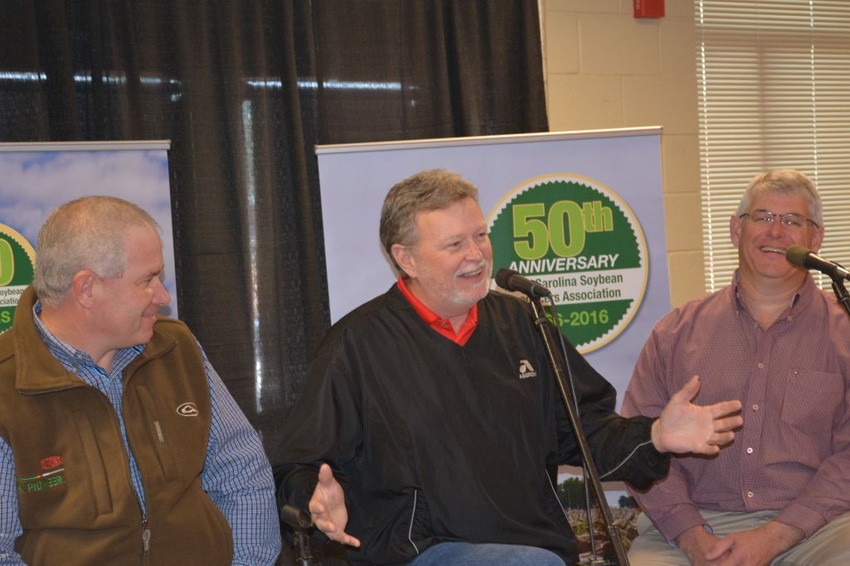
North Carolina farmers Derek Potter and Kevin Matthews farm in different parts of the state, but they both agree that the key to maximizing soybean yields is to choose the right variety, use treated seed and apply fungicides.
Potter, a Pamlico County farmer, and Matthews, a Yadkin County farmer, are known for producing maximum soybean yields. They shared their methods for success during the “Know More, Grow More- Getting the Most From Your Soybean Crop in 2016” panel discussion at the Soybean Producers Forum held during the Southern Farm Show in Raleigh Feb. 5.
Potter and Matthews both stressed the importance of targeting varieties to your farm. They say selecting varieties with the best genetic potential is key and those are usually early maturing varieties.
“You need to make sure the agronomic package fits your farm,” Potter advised. “If you have stem canker, make sure it has stem canker resistance. If you have Southern root knot nematodes, make sure it has nematode resistance,” Potter advised.
In addition to selecting the right variety, Matthews emphasizes the importance of planting date. He said making sure soybean plants get maximum sunlight is critical and successful farmers should target the summer solstice, the longest day of the year.
“Soybeans require a lot of energy, a lot of carbon. Don’t go out there and plant them at the end of March because that’s putting you in an environment ahead of summer solstice. Maybe you need to start with a 5.0 or 5.2 and an early April planting. You should decide which plant dates will work with that variety,” Matthews said.
Both Matthews and Potter protect their seeds with a seed treatment. With the high cost of seed, both farmers consider seed treatments an insurance policy. Matthews points out that seed treatments improve germination, vigor and emergence.
Both farmers rely on fungicides to protect their crops from disease.
Potter produces full-season beans in Pamlico County and uses up to two foliar fungicide applications to target diseases. He considers his fungicide program a preventative measure.
“It paid off handsomely for me last year in terms of seed quality,” he said. “When it was time to harvest our Group IV’s, we had a lot of water, a lot of stress, but our soybeans were still marketable. There was very little damage for the most part,” he said.
Matthews treats all of his soybeans with fungicides and also applies a minimum of two treatments.” I look at that fungicide as my preventative maintenance package,” he explained. “I do not want to see a disease in my soybeans and sometimes I will. My goal is to prevent disease because I can prevent disease a whole of a lot easier than I can cure disease.”
Mike Baker, territorial agronomist with Asgrow, joined Potter and Matthews on the panel and reminded the audience that the two farmers are high yield growers, producing yields in the 50 to 60 bushel per acres or more range. Baker noted that fungicides aren’t always a cost effective investment for farmers who produce beans in the 25 to 30 bushel per acre range.
“If you have a field that is 25 to 30 bushel yield potential, I don’t know if a fungicide is the best choice,” Baker said. “But once you get to 50 bushels plus there is a place for fungicides. Fungicides are designed to do one thing: control diseases. If there is not a disease to be seen, you may not need a fungicide.”
Baker said it is a case-by-case decision, but he stressed that fungicides do have a place in high yield environments. “If you have a great field and we got some cloudy cool weather coming in late August or early September, then it’s good to have a fungicide out there to protect that 50 to 60 bushel yield,” he said.
Turning to weed control, both Matthews and Potter say they battle Roundup-resistant Palmer amaranth. Both use crop rotation and different chemical modes of action to control weeds.
“We do not rely on Roundup hardly any,” Matthew said. “When we do use Roundup, we use a lower rate simply because we are spraying early enough when weeds are no more than an inch tall.”
For his full season soybeans, Matthews applies Envive as a preemergence herbicide and then puts on an application of flumioxazin. “We then come back and use Roundup and Flexstar over the top. We’re hitting them early. We like to put Flexstsar on early before we go into full bloom. We don’t run a full rate because we don’t want to burn anything,” Matthews said.
A key part of Matthews’s weed control effort is using Carbose, made by Genesis Ag, to provide sugar to his soybean plants. “Every time I go across the crop, I apply Carbose for better weed control. The herbicides work better when we add that carbon source,” he said.
Potter explains that all of his soybeans are grown conventionally and he controls most of his weeds with post-emergence herbicides because pre-emergence products don’t work as well in the blacklands. He said the use of Flexstar and rotating soybeans with corn is vital.
“I spray burn down, clean everything up and then come back and plow. The key to my operation is to get back in 21 days with Flexstar when I do have resistant palmer and cleaning it up,” Potter said.
About the Author(s)
You May Also Like






